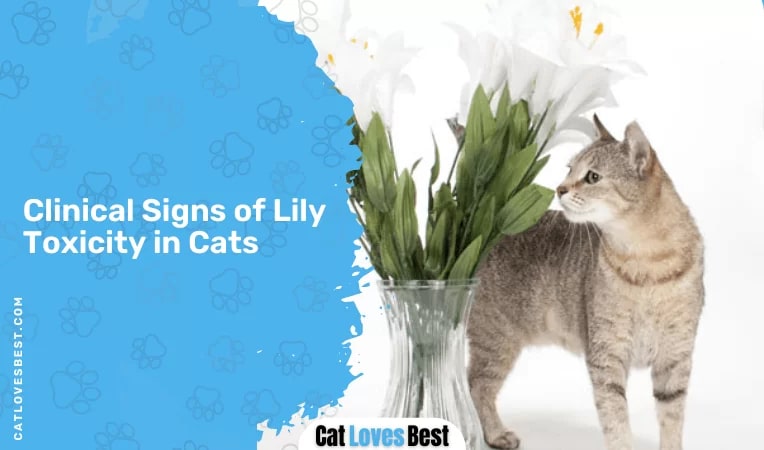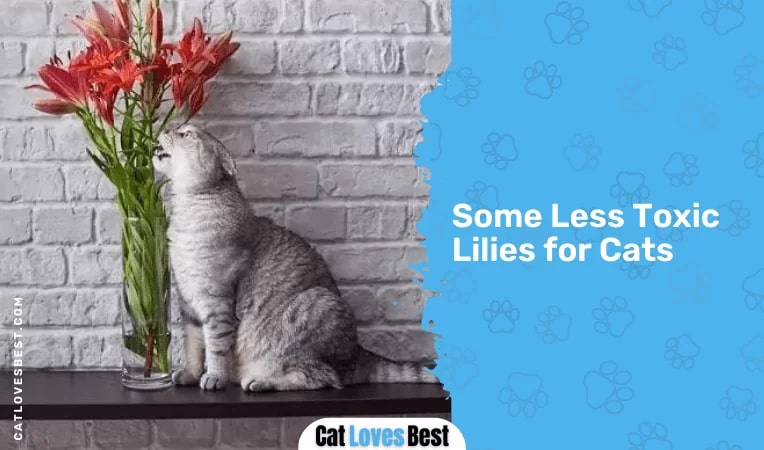Are lilies toxic to cats? Can it kill my cat? Continue reading for the answers!
Our cats can be Dora the explorer when it comes to exploring new things, basically, nothing is spared from their sight and smell! In such a case, when you overhear people talking about the toxicity of lilies to cats, you might wonder, are lilies toxic to cats?
The truth is, the entire lily plant is toxic to cats: the stem, leaves, flowers, pollen, and even the water in a vase. Even if your cat licks a lily flower, she will face bad consequences.

Are Lilies Safe for Cats?
The short answer is no, cats safely can’t eat lilies. In fact, lilies can be lethal for cats. It contains substances that are very dangerous for cats. The entire lily plant is toxic. In large amounts, it can cause death. However, cats are not likely to try to steal it away from under your nose.
So one thing is clear, that lilies are toxic to cats.
The entire plant, including the stem, leaves, flowers, pollen, and even if you have kept it with water in the vase. So sadly you got to drop the idea of having these dazzling flowers in your home if you already have a fur flower, cat!
Clinical Signs of Lily Toxicity in Cats
Once you are done exploring the internet, for all the possible red flags on having lilies around your feline, you got to move on to the next step, which is clinical signs of lily toxicity in cats! Even small parts of lilies can be fatal if ingested or exposed nasally.

So being a responsible pet parent, you would try to keep your cat away from lily as much as you could! But is your cat going to do the same?
A big no! Cats are very curious in nature, and they love to explore all the weird things in the entire universe, where this is just your home!
Initial clinical signs of lily toxicity in cats: even if your cat consumes the water which was in the vase of the Lilly flowers, she will suffer from vomiting, lethargy, drooling, and loss of appetite.
Later clinical signs (12 to 24 hours): increased urination and dehydration, which is also a clear representation of kidney damage.
Kidney failure: the final and most life-threatening, the kidney might fail if no urine is produced. Suppose if Your cat won’t receive appropriate treatment, then she might just die within 36-72 hours.
Diagnosis & Treatment: Lily Toxicity in Cats
The above-mentioned hours you get to treat your cat can make you super worried. As in the worst case, what if your cat eats lily from such a place which is out of sight, and you won’t even know what this poor creature has eaten! Or needs to be diagnosed as soon as possible!
But don’t worry, we will help you in the diagnosis and treatment of this misery!
Diagnosis: if you find a chewed plant in your backyard or in the case where she had eaten from somewhere else, comes home and puke, look for pieces of lilies in it! I know it can make you feel pukish, but it’s your baby!
You got to do it for them!

Blood and urine test: You need to take your cat to the veterinarian for a blood and urine test, which will help them to detect the kidney functioning in them. Some other options are ultrasound exams or a needle biopsy of the kidneys.
Suggestion: if possible then you should take a sample of the lily with you for a better understanding for the vet, it will save a lot of time rather than searching what type of lily was consumed by your poor cat!
Treatment: the first thing your vet will try to do is induce vomiting, this is the first step of early treatment. To absorb the remaining toxic traces in your cat’s gastrointestinal tract, the vet will use activated charcoal, this will absorb all the toxins.
The other process is decontamination, in this your cat is provided with a thick liquid, which gets mixed with the toxins, flushing out of the body through the digestive system.
Vets can only perform this, Intravenous, which usually refers to a way of giving a drug or other substance through a needle or tube inserted into a vein if your cat has not yet stooped producing urine.
The worst case is where your cat develops anuria, which occurs when the kidney is not capable of producing urine. The only option which is left is of performing peritoneal dialysis or hemodialysis on your poor cat.
We know reading this can make you sad, but cheer up! If the process gets successful, there would be no long-term effects on your cat.
As there are different types of lilies on this entire planet and each of them can be poisonous at different levels, so to fasten up the diagnosis & treatment, you should bring that particular lily with you.
Also, immediately calling animal poison control is the most appropriate step to take if you suspect any such symptoms.
First Thing First: Visit Your Vet
We have given you a good amount of steps to diagnose the possibilities of your cat consuming lilies.
But if you have enough evidence for your cat munching on lily, you need to rush to your nearest vet without looking for medications on your own and get the appropriate veterinary care.
Lethally Toxic Lilies for Cats
As we stated before, three are many types of lilies on the earth, now we know that all of them are toxic for cats! But did you know that the level of toxicity differs in each of them, let’s see the most lethally toxic lilies for cats.
| Common name | Scientific name |
| Asiatic lily | Lilium asiaticum |
| Wood lily | Philadelphicum or Umbellatum |
| Stargazer lily | Lilium ‘Stargazer |
| Tiger lily | Lilium tigrinum or lancifolium |
| Rubrum lily | Lilies Lilium speciosum |
| Oriental lily | Lilium orientalis |
| Lily of the valley | Convallaria majalis |
| Japanese Show lily | Lilium speciosum |
Some Less Toxic Lilies for Cats
Not all lilies are behind your cats’ life, some might just intend to hurt them rather than kill! You might get surprised to know that while few lilies can be so lethal for your pets’ life, few of them are not that dangerous. But cats might get cured on their own.

The possible effects your cat might show are: drooling, foaming, vocalizing, vomiting, and diarrhea, it is due to the irritation which is created in your cat’s mouth by the chemicals released out from biting or chewing the lily flower. It’s said that these signs will go away on their own!
Vomiting and diarrhea are one more symptom witnessed when your cat eats Peruvian lily. Let’s look at some less toxic lilies for cats:
| Common name | Scientific name |
| Calla Lilies | Zantedeschia Aethiopica |
| Peace Lilies | Spathiphyllum |
| Peruvian Lily | Alstroemeria |
How to Keep Your Cat Away from Lily?
The best way to keep your cat away from lilies is not to bring or grow them in your house! Because we all know, cats are of curious nature! They will explore each and every corner in your home in their whole lifetime.
If you are someone who loves to grow beauty in their garden or terrace garden, we know what you are thinking! It’s still a no to even growing the less toxic lilies in your garden, you should always prevent lily toxicity in cats by keeping them far away.
Conclusion
Lilies are a symbol of pureness. The honeyed and innocent beauty of the lily flower has given it the association of fresh life and rebirth, but they don’t symbolize the same meaning for cats! Lilies are toxic for cats.
So if you ask yourself that, are lilies toxic to cats entirely? The entire plant, including the stem, leaves, flowers, pollen, and even if you have kept it with water in the vase. The only thing you can do to save your cats from this poisonous flower is not let them in your home, garden, or even terrace!
References
- Are Lilies Poisonous To Cats? – Your Vet Online
- Why are lilies extremely toxic to cats? – RSPCA
- A Comprehensive Study of Easter Lily Poisoning in Cats – Journal of Veterinary Diagnostic Investigation

